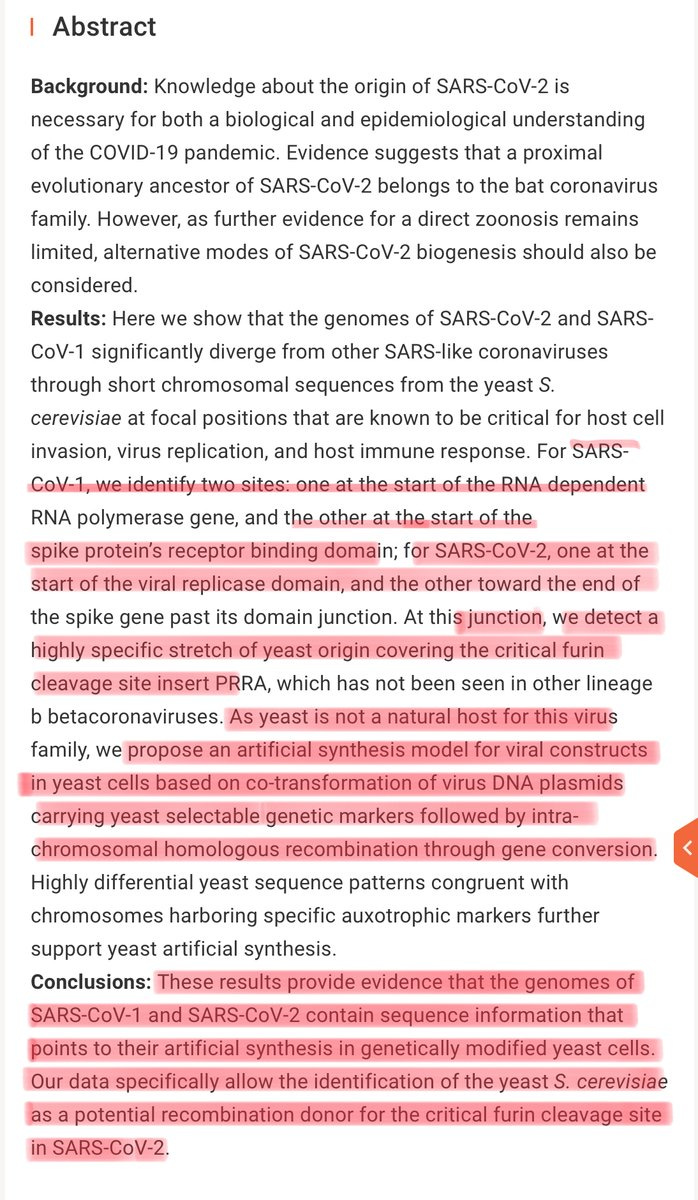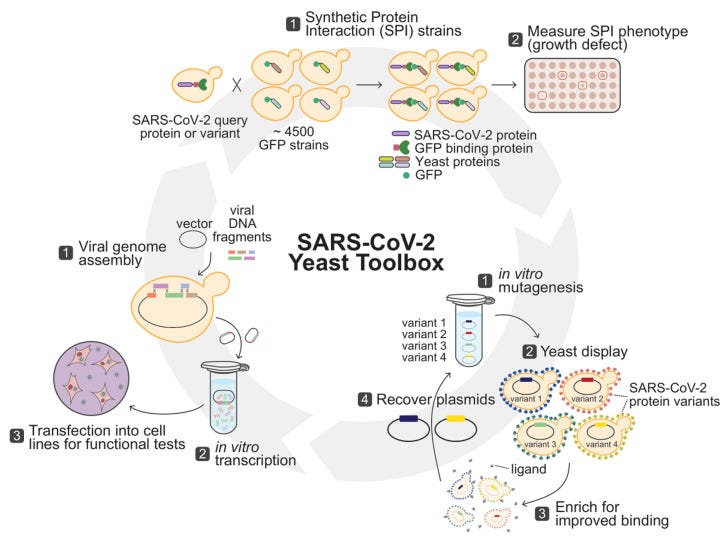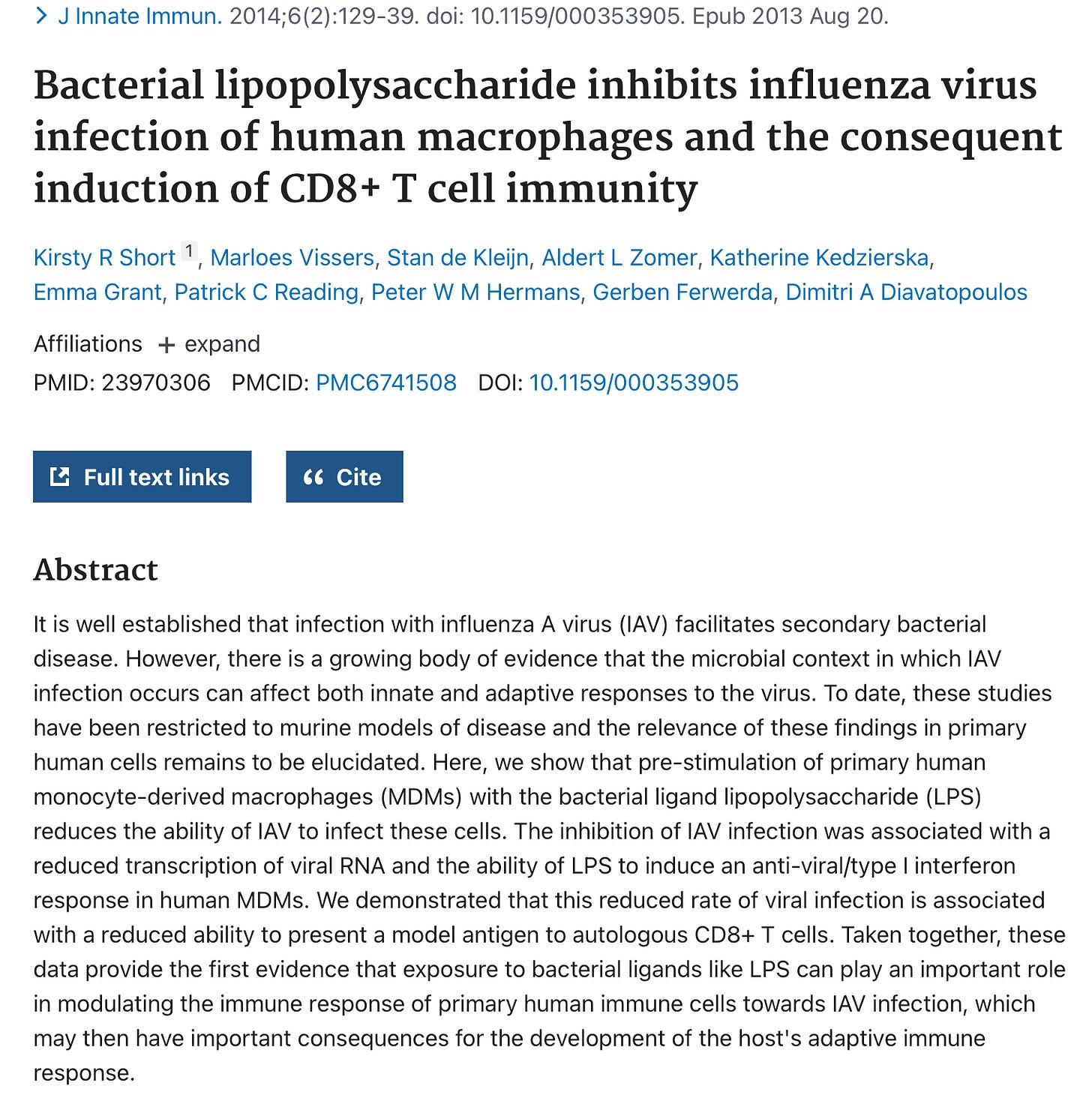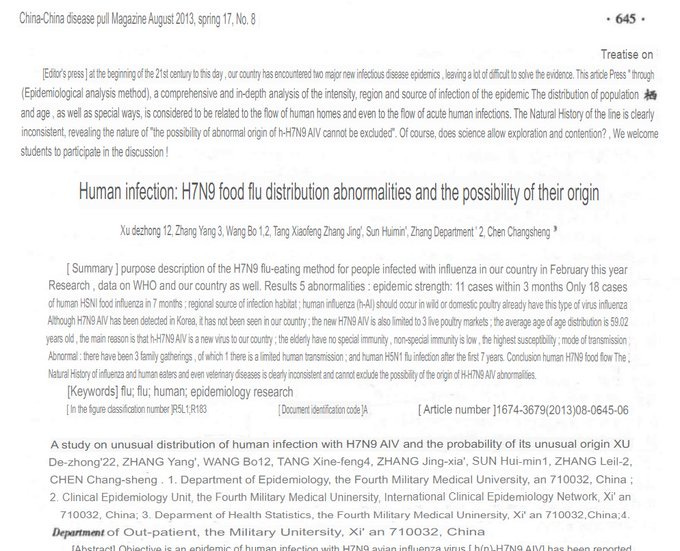I will leave the title as Sunday because it is when I usually publish conspiracy-prone, exploratory, self-amusing articles. The lateness comes from both my mother and grandmother being quite sick from a respiratory infection (they don’t supplement with anything if you were about to ask). Now better I can spend the appropriate time writing.
Second order of business, while the conspiracy articles have a lot of science behind them, this one is circumstantial at best, with distant data points. Interpret this as pure exploratory, throwing things into the ether.
The Wasp Venom part of this article was brought to my attention by Juniper Berry on Twitter, he just asked why nobody was talking about one specific paper, completely ignored since the start of the pandemic. His inquiry comes from a very early paper.
This paper is a somewhat quintessential piece of the debate on Covid origins, it remains a hot topic, and many of the authors are PLA-connected scientists (this will be important context later on). Hindsight is 2020, and certain topics are forbidden but even the WIV was kind enough to provide some clues from the get-go.
This is the amino acid sequence alignment of the S1 protein compared to other SARS-CoV viruses. Insert 4 is missing. Not the reason we are here, the reason we are is below.
My interpretation and whole scientific approach is everything has unexplored connections.
For full clarity, what we are about to discuss below is beyond “advanced”, this was done prior to 2020 and prior to the Large Language Model, Machine Learning crazy, so this would entail covert, cutting-edge dual-use research, picking up pieces of evidence, even largely distant related is already hard enough, concrete evidence entails Intelligence gathering.
One of the first public (as in published and easily accessible for the public to see) analyses of the “novel coronavirus”, in this case, metagenomic analysis (analysis of an entire sample, not just an isolated pathogen) of patient ICU06. Here is where things get… theoretical.
Glypta fumiferanae ichnovirus segment C10, complete sequence could be ascribed as a contaminant in the samples and so would C9, if not the fragment sequence being a known contaminant lung squamous cell carcinoma (LUSC), a cell line used in cancer research.
Hyposoter fugitivus ichnovirus segment B5 could also be ascribed as contamination, it is not present in any cell line I am aware of, but this segment has some interesting properties :
viral innexin-like protein; inexin proteins form channels between adjacent cells to connect cytoplasm; polydnaviral innexin-like proteins may serve to alter cell-cell signalling in wasp-parasitized insects
Innexin is the invertebrate respective of Connexin, which is a group of proteins that form small channels in cells to transmit metabolites, and small signal molecules so cells close to each other can “talk” between themselves. Vinnexin (Virus Innexin) from wasps can affect cell membrane potential. Both Glypta and Hyposoter are parasitic wasp viruses, contained in their venom.
Dulcamara mottle virus is a plant virus, its only use here would be as a genetic engineering viral vector, specifically for gene delivery in plants, or in an exceptionally advanced stage bioproduction. The most likely explanation here would be contamination or purposeful subterfuge to mislead anyone investigating. Next…
Saccharomyces cerevisiae Killer Virus M1, complete genome → Saccharomyces cerevisiae is a well-known yeast, it has many, many uses but the one of most interesting uses is…synthetic biology. But here we don’t have the yeast, but one of its virus, the Killer Virus M1.
In regards to yeast, and specifically to Sac. Cere., the name signifies a virus that infects the yeast, and makes that yeast produce a toxin, usually with potent antimycotic effects, giving it the “Killer” aspect, because it will kill any sensitive yeast around, but often the infected yeast will remain. The only reason you would introduce M1 in a synthetic virus or have its genome in your sample would be to act as a biocontrol. To kill any other sensitive yeast strain to keep the strain you want alive.
And at this point, I was reminded of a tweet from 2022, written by Daoyu.
You grow fragments and pieces (DNA) in yeast, cut it, “glue” it, and put it together. 1 Viral Genome Assembly in the image below. A more recent paper on the approach “Efficient assembly of a synthetic attenuated SARS-CoV-2 genome in Saccharomyces cerevisiae using multi-copy yeast vectors”. Of course we can’t forget another watershed moment and publication “Rapid reconstruction of SARS-CoV-2 using a synthetic genomics platform”, when researchers built SARS-CoV-2 in a completely synthetic manner, using the same yeast.
viral subgenomic fragments were generated using viral isolates, cloned viral DNA, clinical samples or synthetic DNA, and these fragments were then reassembled in one step in Saccharomyces cerevisiae using transformation-associated recombination cloning to maintain the genome as a yeast artificial chromosome.
This yeast aspect has been discussed by researchers interested in the synthetic origins of Covid. So far we have, a protein that can change how cells talk to each other, another that is present in a cell line, and a whole virus genome that is most likely nothing. Proteus phage VB_PmiS-Isfahan is where things get… interesting. As the name implies VB_PmiS-Isfahan is a Proteus bacteriophage, a virus that infects bacteria.
VB_PmiS-Isfahan is recently discovered and all its uses are yet to be revealed, but one of the first and most significant effects, especially for disease treatment and biotech usage depolymerase, and matrix degradation of biofilms. Cutting-edge usage would be creating Virus-Like Particles, Gene therapy, or a way for bacterial infection treatment (if the phage genome is functional and produces functional proteins, it can be used to deal with bacterial infections)
Now the biofilm “dissolving” aspect of this phage and its presence in the early samples has a few interesting possibilities.
The human microbiome is a reservoir of SARS-CoV-2 advantageous mutations, and I argue that SARS-CoV-2 interaction with biofilms is what enabled it at first to persist and cause significant, often paradoxical damage. So even from the inception and engineering of the progenitor of the virus, biofilms were of interest. Now, I never understood why would you want your synthetic chimeric virus to interact so deeply with bacteria, and especially endotoxins.
Often looking at it from an “offensive” perspective, to cause damage. But months ago I started looking at everything from a true dual-use perspective. Defensive use in this case.
Exposure to endotoxin can positively modulate your immune response towards Influenza A viruses, it can protect you from severe inflammatory reactions and infection (at the cost of secondary bacterial infections, and a lot of complex interactions). So did the PLA know about a coming Influenza Pandemic and retrofitted one of its projects into a viral interfering “live vaccine” ?
Given the quite extensive level of interaction of SARS-CoV-2 with dozens of receptors, and dozens of pathogens, creating hundreds of propagating interactions, did the endotoxin interaction played other roles ? Well, it took some digging.
Toxins also have another name. “Tumor Antigen Coupling Binding Vectors”, and they “can improve antigen immunogenicity. Antigen-optimized design based on protein structure, such as virus-like particles vaccines, can enhance the immune response.”
I wouldn’t particularly blame you for thinking this is beyond conspiratorial and far-fetched if not by the odd, published clinical cases.
SARS-CoV-2 infection-reducing tumors, another one from 2021, a
Spike Protein inhibits growth of prostate cancer, Unexpected tumor reduction in metastatic colorectal cancer patients during SARS-Cov-2 infection.
A very recent paper, and one of the hottest takes I’ve seen recently proposes something similar, “Molecular mimicry of SARS-COV-2 antigens as a possible natural anticancer preventive immunization”.
Back in the 1990’s there was research into using endotoxins as a potential cancer treatment.
When you deal with human beings, you are dealing with one if not the most complex biological systems in nature, so intention and goal can go out of the window particularly fast when faced with reality. How one could explain the aggressive cancer acceleration besides the many other pathways I have covered and one that is intrinsically connected to this ?
Well, when you are using a cutting-edge, live, chimeric-targeted delivery system for your “universal vaccine-weapon” you can quite dose how much endotoxin each person will be exposed to. A flood of endotoxins begets Endotoxin Tolerance.
Endotoxin Tolerance Creates Favourable Conditions for Cancer Development
Macrophages, depending on their phenotype, can either destroy or stimulate cancer cells. Therefore, it is very important to identify the conditions under which they adopt a dangerous phenotype. Our study investigated the impact of endotoxin tolerance (ET) on macrophage behaviour and its role in cancer development. By utilizing in vitro models and diverse research methods, including examining conditioned medium effects on 3D cancer cell cultures and studying macrophage-cancer cell crosstalk, we discovered that ET-induced macrophage reprogramming leads to the release of factors that promote a cancer-favourable environment. Our findings highlight the dual nature of ET as a mechanism, potentially contributing to cancer progression. This work suggests that targeting ET could offer novel avenues for cancer prevention and treatment. To the best of our knowledge, our research group is the first to uncover this adaptive mechanism’s potential role in cancer development.
While many open-ended questions remain, my closing remarks veering into conspiratorial territory were already written in 2022.
Perhaps not messed, but purposefully retrofitted for an impending emergent pandemic of unknown origins ? A pandemic to stop a pandemic. And for future reference to myself and anyone else, and hopefully, HMGB1 is still fresh in your mind.
CRISPR-Cas9 Direct Fusions for Improved Genome Editing via Enhanced Homologous Recombination
The fusion of human HMGB1, HMGN1 and Histone 1 globular domain (H1) to Cas9 increased editing activity by 1.7–2.5-fold compared to unfused controls. A synergistic effect of double fusion of Cas9 with these proteins increased activity by 2.5–3.4-fold. The effect of doubly fused Cas9 to two different combinations, Cas9-HMGB1-HMGN1 and Cas9-HMGN1-H1, showed twice the efficiency in genome insertion compared to unfused Cas9
Would you look at that… huh. Enhancing gene therapy, CRISPR-Cas9 by adding HMGB1. Well, the world is full of surprises and fun. See you again soon, with good news this time =).
I am grateful for your support !













It all sounds like a witches brew from the cauldrons of Hell! God help the human race! 🙏🏻
Professor - "purposefully retrofitted for an impending emergent pandemic of unknown origins ? A pandemic to stop a pandemic."
Your getting warmer.
"why nobody was talking about one specific paper"
Another misdirect into a paradoxical putative progenitor replete with deleted NIH sequence records.
To the question: because some knew better to keep their mouths shut Mr. Mulder